Flexible Evaporation-Induced Generator for Wearable Power Generation
FAYETTEVILLE, GA, UNITED STATES, November 21, 2025 /EINPresswire.com/ -- In the exploration process of relevant research, researchers have successfully developed a flexible evaporation-induced generator (EIG) with relatively excellent performance through a triple gradient synergy strategy. These devices not only achieve a relatively high peak power density but also have the potential to adapt to wearable scenarios by virtue of their good flexibility.
The energy and environmental crisis triggered by excessive fossil fuel consumption is becoming increasingly acute, while alternative energy sources such as solar and heat energy are often constrained by weather conditions and application scenarios. In the field of wearable electronics, traditional evaporation-induced generators (EIGs) can capture evaporation energy from the natural water cycle, but they generally suffer from shortcomings such as low power density, poor flexibility, and the need for continuous water supply, making them unable to meet practical application requirements.
In a study published in the journal Wearable Electronics, a research team from Chinese universities proposed a new energy harvesting solution-a novel flexible EIG that can simultaneously achieve high-efficiency power generation and adapt to wearable scenarios.
“The dynamic application scenarios of wearable devices place relatively high demands on the flexibility and stability of energy devices,” says senior and co-corresponding author Xuebin Wang, from the College of Engineering and Applied Sciences at Nanjing University.” Traditional carbon-based EIGs usually have two types of problems: one is that the output power is difficult to meet the driving needs of some electronic devices, and the other is that their structure is relatively rigid, making it hard to fit the human body curve.”
In addition, the characteristic of devices requiring frequent water replenishment affects their portability to a certain extent. “One of the cores of flexible EIG research lies in balancing “power generation efficiency” and “structural adaptability”,” adds Wang. “In traditional preparation processes, improving ion migration efficiency often requires sacrificing material flexibility, which is one of the long-standing technical challenges in this field.”
The team found that by constructing a “hydrophilic-hydrophobic” asymmetric electrode structure (CF@PEDOT hydrophilic top electrode and CP hydrophobic bottom electrode) and introducing an MPP hydrogel functional layer with a triple hydrogen bond network, a “water-ion-temperature” triple gradient can be constructed simultaneously.
The design scheme proposed in the study, relying on gradient synergy to drive coupled “mass-charge-heat” transfer, is not only expected to improve the problem of low ion transport efficiency of traditional EIGs, but also likely to retain the flexibility and stability of the device.
“Relevant experimental results show (under current test conditions) that the peak power density of this EIG can reach 0.79 mW/cm2,” shares first author Wenjing Duan, also from Nanjing University. “In simulated scenario tests such as finger bending and breathing humidity fluctuations, the device has not shown obvious performance degradation temporarily.”
With the help of gradient collaborative design, the team’s design scheme is expected to expand the applicable material library to more flexible polymer systems. The researchers hope that the results can provide references for the academic community to further explore the application of “multi-gradient synergy” in energy devices, and assist flexible EIG to gradually advance from the laboratory to practical application scenarios such as clinical monitoring and smart wearables.
References
DOI
10.1016/j.wees.2025.09.002
Original Source URL
https://doi.org/10.1016/j.wees.2025.09.002
Funding Information
This research was part of the National Natural Science Foundation of China (U23B2075, 52272039, 51972168), the Fundamental Research Funds for the Central Universities–CEMaC GeoX Interdisciplinary Program (2024ZD07), the Natural Science Foundation of Jiangsu Province (BK20231406), the Key Research and Development Program of Jiangsu Province (BE2023085) and the Postgraduate Research & Practice Innovation Program of Jiangsu Province (KYCX25-0193)
Lucy Wang
BioDesign Research
email us here
Legal Disclaimer:
EIN Presswire provides this news content "as is" without warranty of any kind. We do not accept any responsibility or liability for the accuracy, content, images, videos, licenses, completeness, legality, or reliability of the information contained in this article. If you have any complaints or copyright issues related to this article, kindly contact the author above.

